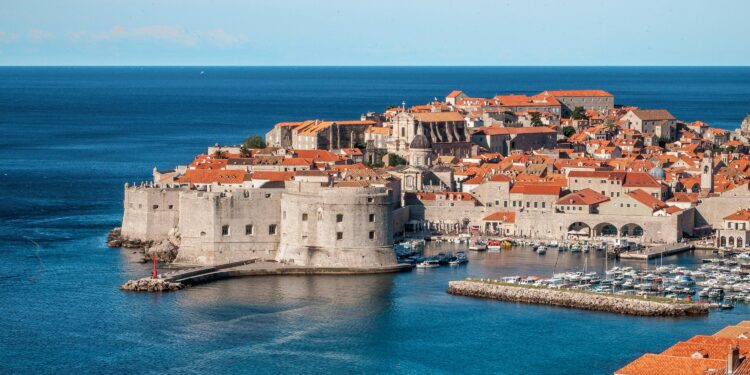Set-Jetting: How Streaming Shapes Our Travel Bucket Lists

Once upon a time, glossy brochures and travel magazines determined where people longed to go. Today, inspiration comes not from print but from the screen. Streaming platforms like Netflix, HBO, and Prime Video are not just shaping entertainment. They’re reshaping travel destinations around the world.
From the cobblestone streets of Paris featured in Emily in Paris to the rugged coastlines of Croatia immortalised in Game of Thrones, global audiences are booking tickets based on the backdrops of their favourite shows. This phenomenon, known as set-jetting, is turning fictional worlds into real-world travel destinations and tourism booms.
The Rise of Set-Jetting
The concept isn’t entirely new. Fans of The Lord of the Rings have been flocking to New Zealand for decades. But the rise of streaming has accelerated and democratised the trend. Shows reach global audiences instantly, and travel interest spikes just as quickly.
Google Trends regularly shows surges in searches for travel destinations featured in hit shows. When HBO aired The White Lotus in Sicily, hotel bookings skyrocketed. Similarly, Scotland saw tourism growth linked directly to Outlander, while Croatia’s Dubrovnik transformed into one of the world’s busiest ports of call thanks to Game of Thrones.
Set-jetting has become so powerful that tourism boards now collaborate with studios, anticipating the next big wave of visitors long before the season finale drops.
Emily in Paris: The Glamour of Everyday Spaces
Few shows exemplify the impact of streaming on travel destinations as clearly as Netflix’s Emily in Paris. Its sweeping shots of the Seine, rooftop terraces, and chic cafés have inspired countless viewers to add Paris to their travel itinerary.
But what’s fascinating is the focus on everyday spaces rather than landmarks. Fans don’t just want the Eiffel Tower! They want the café from Episode 3, the staircase in Emily’s apartment building, and the flower markets. By glamorising the mundane, the series reshapes how travellers experience Paris, seeking authenticity through fiction.
Game of Thrones: Fantasy Meets Reality
Perhaps no series has had as dramatic an impact on travel and tourism as HBO’s Game of Thrones. Shot across multiple countries, including Northern Ireland, Croatia, Iceland, and Spain, the show turned entire cities into must-see travel destinations.
Dubrovnik became synonymous with King’s Landing, drawing cruise ships and guided tours. Iceland’s glaciers and volcanic terrain surged in popularity among adventure travellers. Northern Ireland developed an entire industry of themed tours, generating millions for local economies.
The impact here is not just about fantasy but about narrative power. Travellers want to stand in the exact spots where their favourite characters fought battles or made history, blurring the line between fiction and reality.
Outlander: Heritage Tourism Reimagined
While Emily in Paris and Game of Thrones highlight cities and landscapes, Outlander showcases heritage and history. The show, set in 18th-century Scotland, has brought global attention to castles, stone circles, and Highland villages.
For Scotland, the effect has been transformative. Visitors don’t just want a photo. They want to immerse themselves in the culture, weaving tartans into their travel itinerary or attending reenactments. Set-jetting here intersects with cultural tourism, deepening visitors’ engagement with history through the lens of fiction.
The White Lotus: Luxury Tourism on Screen
The White Lotus proves that travel destinations don’t need fantasy or history to entice, and luxury alone is enough. The show’s settings in Hawaii, Sicily, and Thailand showcase five-star resorts with breathtaking views, inspiring affluent travellers to book stays at those exact properties.
According to local tourism boards, Sicily saw double-digit increases in interest after Season 2 aired. The allure lies in aspiration: the chance to live, however briefly, like the characters onscreen. The show reframes resorts not just as hotels but as cultural travel destinations, redefining luxury travel and tourism.
Why Set-Jetting Resonates
What makes set-jetting so powerful? At its core, it taps into three impulses:
- Emotional attachment – Viewers form bonds with shows and want to extend that connection in the real world.
- Visual storytelling – High-definition cinematography makes landscapes feel tangible and inviting.
- Social sharing – Travellers love posting side-by-side shots of “me vs. the scene,” turning set-jetting into Instagram content.
Unlike traditional tourism marketing, set-jetting feels organic. These travel destinations are not the result of ad campaigns but of cultural obsession.
The Economic Impact of Streaming on Tourism
The rise of set-jetting has had measurable effects on local economies. Croatia’s tourism industry saw billions in growth attributed to Game of Thrones. In Scotland, Outlander-driven tourism created thousands of jobs.
Even cities already saturated with tourists, like Paris, benefit from fresh interest when shows spotlight lesser-known neighbourhoods. For hotels, restaurants, and tour operators, streaming has become a powerful marketing channel they didn’t have to pay for.
Tourism boards now actively court film and TV productions, recognising the long-term payoff. Shooting in a picturesque location doesn’t just showcase a story. It creates a global commercial for popular travel destinations.
Challenges of Set-Jetting
Despite the benefits, set-jetting raises concerns. Local residents often complain about overtourism, with small towns overwhelmed by sudden influxes of visitors. Dubrovnik, for instance, had to regulate cruise ships after becoming inundated by fans.
There’s also the risk of disappointment. Travellers arrive expecting fantasy and find everyday reality instead. A castle may look less grand without post-production effects, or a café may be too crowded to feel magical. Balancing expectation with reality is an ongoing challenge for travel and tourism stakeholders.
How Travellers Can Engage Responsibly
For those inspired by their favourite shows, responsible set-jetting means:
- Supporting local businesses rather than only global chains.
- Exploring lesser-known filming spots to ease crowding.
- Respecting cultural and environmental contexts (don’t trample heritage sites for the perfect photo).
- Adding non-screen-inspired stops to a travel itinerary to experience authentic culture beyond the show.
Done mindfully, set-jetting can enhance both traveller satisfaction and local sustainability.
The Future of Travel Inspiration
As streaming expands, the influence on travel destinations will only grow. Future hits could spark new waves of visitors to underexplored regions, reshaping global tourism maps. Interactive formats (think VR extensions of TV shows) may blur fiction and travel further, letting fans “preview” locations before booking flights.
At the same time, streaming-inspired travel is likely to push more travel destinations to market themselves as filming-friendly, building partnerships with studios to ensure cultural and economic impact.
Streaming as the New Compass?
In a world where stories drive desire, streaming has become the compass for modern explorers. Viewers no longer just consume narratives. They pursue them. Whether sipping coffee in a Paris café, walking the cobbled alleys of Dubrovnik, or lounging poolside in Sicily, fans transform fiction into lived experience.
Set-jetting proves that travel is no longer only about geography. It’s about emotion, identity, and culture. As our screens continue to tell stories that transport us, our travel destinations will keep shifting accordingly. This is just more proof that the line between story and journey has never been thinner.







